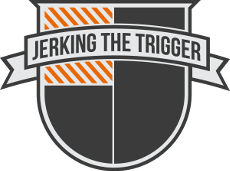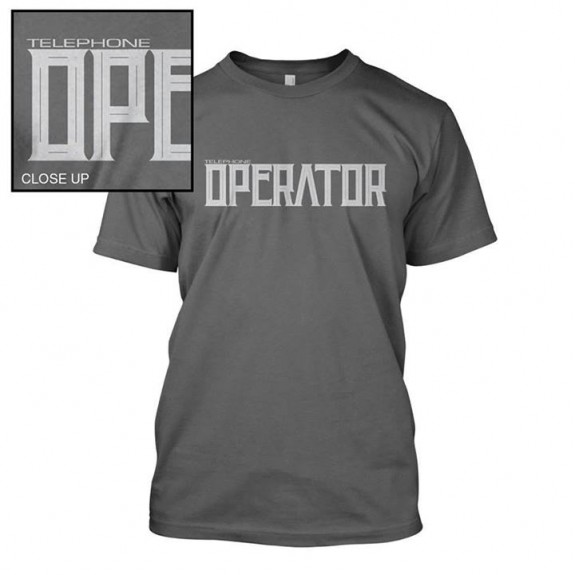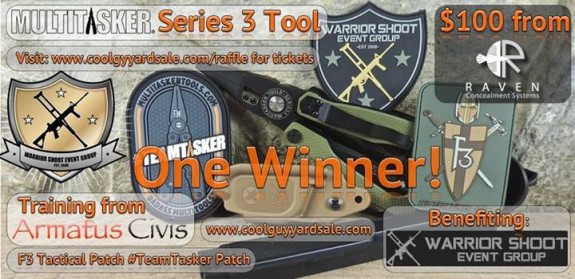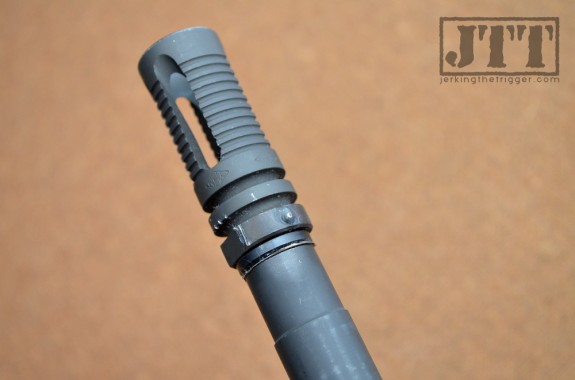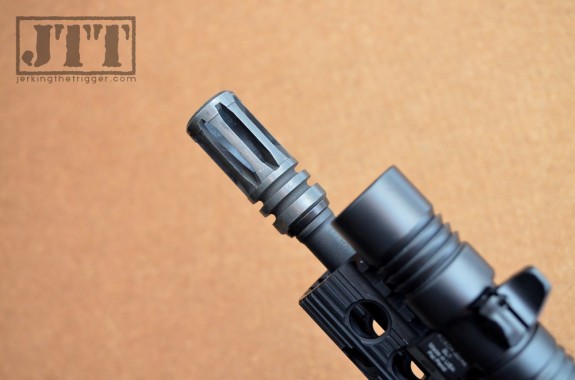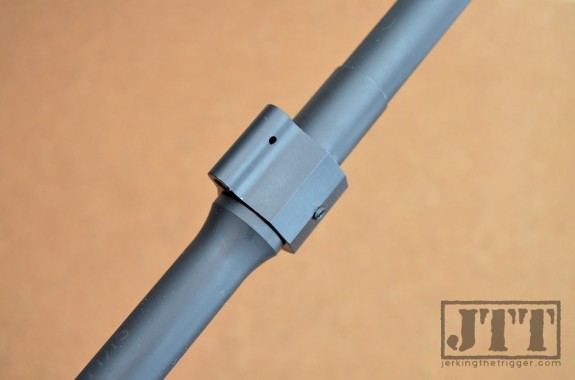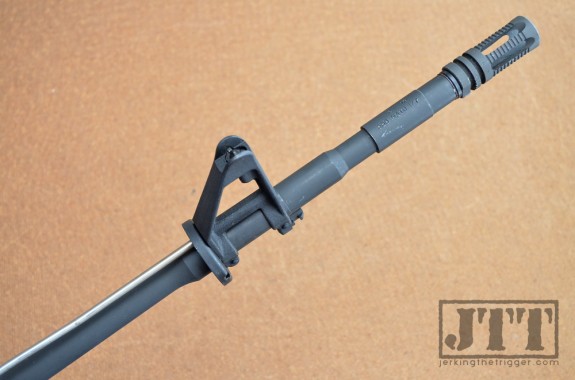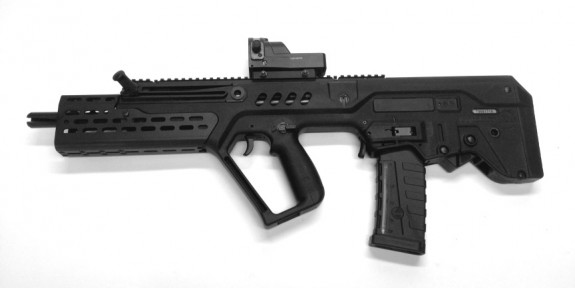One Ringy Dingy. Two Ringy Dingy. Check out RE Factor Tactical’s limited Operator shirt.
Vltor SHOT Show Promo Video
 Vltor showed this video in their booth during SHOT Show. It is light on detail but it does give you a glimpse of their new VWS rifle line “in action”.
Vltor showed this video in their booth during SHOT Show. It is light on detail but it does give you a glimpse of their new VWS rifle line “in action”.
You can find information about the new VWS line at the new and improved Vltor website.
CGYS Raffle to Benefit WSEG
Cool Guy Yard Sale is a hosting a raffle to benefit Warrior Shoot Event Group. There are some really nice prizes but more importantly, this is a chance to help fund an organization that is doing some pretty nice things for wounded veterans.
I strongly encourage you to visit Cool Guy Yard Sale to read more about Warrior Shoot Event Group and the raffle.
14.5″ Barreled Uppers – Maximizing Performance and Your Options
14.5” barrels with permanently attached muzzle devices are very popular among AR-15 builders for good reason. This configuration saves weight and provides the shortest possible barrel length without having to apply for a tax stamp. However, for all the upsides, there are also downsides that it seems some shooters don’t think about until it is too late.
The moment that muzzle device is pinned and welded to your barrel, your options become extremely limited. You obviously can’t remove your muzzle device easily, you can’t fully remove your gas block, you can’t fully remove your barrel nut, and all of that means your hand guard options are limited.
The good news is that, with a little forethought and planning, you can maximize your available options should you ever want to change the configuration of the carbine later.
Choose Your Muzzle Device Wisely
Choosing a muzzle device is easy when you know you can just take it off and replace it. It becomes a lot more challenging when you are going to be attaching it permanently. You will have to live with the device that you choose for a long time or go through a headache to replace it. I tend to choose closed end flash suppressors for perm attachment for several reasons.
First, the muzzle devices that I have seen damaged most commonly are long, pronged flash suppressors. I have seen prongs bent or even seen them bloom open like a flower as round counts increased. That is rare, but it can happen.
Second, flash suppressors are more stable in terms of development. If you attach the hot new muzzle brake, it won’t be the hot new muzzle brake for long. Flash suppressors tend to have a longer shelf life and seem to less subject to the whims of a fickle muzzle device market. Choose a device with a long track record of working well for your specific application.
All of the above basically adds up to an extended A2 flash suppressor for me. It is reasonably effective as a flash suppressor, never goes “out of style,” inexpensive if you have to destroy it when it is removed, and it has a closed end design that you are unlikely to damage or wear out. It also happens to be the most cost effective choice.
You could also choose a device like the Adams Arms Manimal which is an extended A2 style flash suppressor with a small enough outside diameter to allow the gas block, hand guard cap, and barrel nut to slip over it. That would basically mitigate everything I am saying in this article but the Manimal is not as thick as most devices and its long term reliability is unproven at this point.
I am not dogmatic about choosing a flash suppressor for this application. Choose whatever device works best for you after a realistic assessment of your skill, intended application, and budget.
Gas Block Considerations
The standard front sight base is probably your more versatile gas block option for a 14.5” barrel. It can be used in conjunction with the hand guard cap to allow the use of various inexpensive non-free float hand guards like standard hand guards, Magpul’s MOE hand guards, or various drop-in railed hand guards.
The standard FSB can also be ground down to work as a low profile gas block while still in place on the barrel. This allows the use of various extended free float rails (more on this later).
If you know you are going to be using an extended free float rail, you can start with a low profile gas block.
Gas System Considerations
There are a number of 14.5” barrels out there with mid-length gas systems and while they tend to be very soft recoiling, I generally prefer a carbine length gas system on a 14.5” barrel. Carbine length gas will offer the most hand guard options, be a little less picky about ammo, and get in the way a little less when it comes to mounting accessories on extended hand guards.
I should probably explain a few of those a little further. I say carbine length gas systems have the most hand guard options because of the various front sight cutout rails that are available. There are very few of these available for the mid-length gas system and some of those that are available are too long to be used on a 14.5” barrel.
The comment regarding getting the way less refers mostly to the slim, slick sided free float tubes that allow you to direct connect accessories. Those systems tend to use screws with some kind of nut or plate to attach which can be long enough to contact the gas block in some situations. If you are using an extended hand guard, you are likely to be attaching most of your accessories right around the part of the barrel where the mid-length gas black sits which is the widest part of the barrel and thus the most likely place for there to be undesirable contact. This is less of a concern if your gas block is very low profile, your rail has a larger diameter, or you are using a railed hand guard.
There really isn’t a wrong answer here but if you want the configuration that gives you the most options down the road, a carbine length gas system is probably the way to go.
Stick to Hand Guards that Use the Standard Barrel Nut
The number one thing to avoid when you are building a 14.5” carbine is free float rails with non-standard barrel nuts. Once the muzzle device is attached permanently, that barrel nut isn’t coming off which means you are likely going to be stuck with that hand guard for a long, long time. If the rail that you are using is discontinued by the manufacturer, you may find yourself up the creek with a paddle.
Thankfully, there are several rails on the market that attach to the standard barrel nut. There always has been and there likely always will be.
Two piece designs like the Centurion Arms C4 rails are especially well suited to use on barrels with permanently attached muzzle devices since they can be attached while the FSB is still in place.
If you have a low profile gas block, you have even more options. The Samson Evolution Rails (and derivatives), Fortis REV, Apex GatorGrip and others attach to the standard barrel nut and can be slipped over a low profile gas block to install.
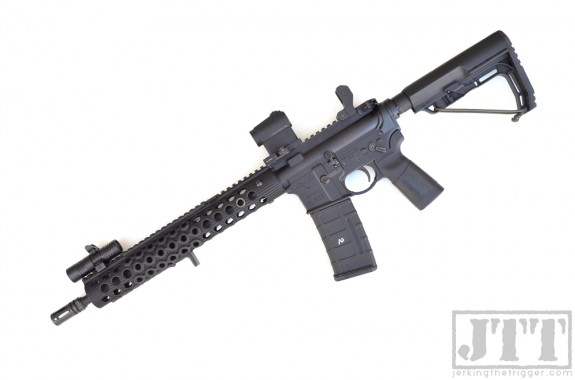
I no longer recommend Troy products as a result of various hiring decisions they have made but their hand guards do work very well in this role.
Adding it Up
If you add up everything above, the most versatile barrel configuration to use on a 14.5”, non-NFA build is probably one with a standard FSB, carbine length gas system, and a standard barrel nut. This configuration will render the maximum amount of choices right away and in the future. The muzzle device choice is a bit more personal and something you will have to sort out on your own.
Don’t get trapped with a 14.5” carbine that can’t adapt as your shooting style changes and the state of the art advances. If you follow the advice above, you will always have options.
Manticore Arms Tavor ARClight XTL
In this industry, the only thing better than an accessory rail is a longer accessory rail! Check out the new Manticore Arms Tavor ARClight XTL – an extended version of their popular ARClight rail.
